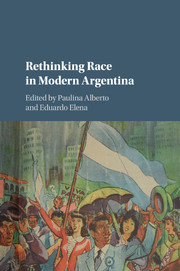Book contents
- Frontmatter
- Contents
- List of figures
- List of tables
- Notes on the contributors
- Preface
- Introduction: The shades of the nation
- PART I HISTORIES OF RACE IN THE TWENTIETH CENTURY
- 1 Insecure whiteness: Jews between civilization and barbarism, 1880s–1940s
- 2 People as landscape: The representation of the criollo Interior in early tourist literature in Argentina, 1920–30
- 3 Black in Buenos Aires: The transnational career of Oscar Alemán
- 4 La cocina criolla: A history of food and race in twentieth-century Argentina
- 5 “Invisible Indians,” “degenerate descendants”: Idiosyncrasies of mestizaje in Southern Patagonia
- 6 Race and class through the visual culture of Peronism
- 7 Argentina in black and white: Race, Peronism, and the color of politics, 1940s to the present
- PART II RACE AND NATION IN THE NEW CENTURY
- Epilogue: Whiteness and its discontents
- Collective bibliography
- Index
2 - People as landscape: The representation of the criollo Interior in early tourist literature in Argentina, 1920–30
from PART I - HISTORIES OF RACE IN THE TWENTIETH CENTURY
Published online by Cambridge University Press: 05 March 2016
- Frontmatter
- Contents
- List of figures
- List of tables
- Notes on the contributors
- Preface
- Introduction: The shades of the nation
- PART I HISTORIES OF RACE IN THE TWENTIETH CENTURY
- 1 Insecure whiteness: Jews between civilization and barbarism, 1880s–1940s
- 2 People as landscape: The representation of the criollo Interior in early tourist literature in Argentina, 1920–30
- 3 Black in Buenos Aires: The transnational career of Oscar Alemán
- 4 La cocina criolla: A history of food and race in twentieth-century Argentina
- 5 “Invisible Indians,” “degenerate descendants”: Idiosyncrasies of mestizaje in Southern Patagonia
- 6 Race and class through the visual culture of Peronism
- 7 Argentina in black and white: Race, Peronism, and the color of politics, 1940s to the present
- PART II RACE AND NATION IN THE NEW CENTURY
- Epilogue: Whiteness and its discontents
- Collective bibliography
- Index
Summary
In the 1930s, a series of mountain districts in Argentina began receiving thousands of tourists from Buenos Aires and other Argentine cities, attracted to the spellbinding vistas and the brisk mountain air. The most popular destinations, such as Lake Nahuel Huapi in Patagonia, the Andean foothills in Mendoza, the Sierra in Córdoba, and the Calchaquí and Humahuaca valleys in the Northwest, offered a diversity of climates and landscapes for the fledgling Argentine leisure class. The tourism industry brought roads, hotels, and vacation houses where only small rural communities existed before. It also placed the extreme opposites of the Argentine social, ethnic, and regional spectrum in contact with each other: while the privileged vacationers were urban Argentines of primarily European descent – some of them members of the old patrician elite and others middle-class children of the recent wave of European migration – the hosts tended to be poor, rural, dark-skinned peasants. Some of these peasants were indigenous people, such as the Kollas of Humahuaca or the Mapuche in Nahuel Huapi, while others were mestizo (criollo in Argentine parlance) with strong indigenous roots, such as the inhabitants of the Uco, Punilla, and Calchaquí valleys. The physical development of tourism displaced the existing populations but did not eliminate them. Instead, they became indispensable in sustaining the tourist economy as a source of cheap labor. Furthermore, the dark-skinned, “traditional” peasants became part of the tourist attraction itself, precisely because they represented a visual and cultural contrast with the wealthy, “modern,” and light-skinned Argentine tourists.
Arguably, the tourist encounter in these Argentine mountain destinations of the 1930s both revealed and shaped the complexities of national constructions of race and ethnicity. In particular, it hastened the process of racialization of the rural poor, analyzed by anthropologist Claudia Briones, in which the pre-immigration mixed-race population became integrated into the nation in a permanently subordinate position. The peculiarity of the Argentine case, however, rests precisely upon the myth of the white nation that prevailed among Argentine elites since the second half of the nineteenth century. The “darkening” of the subaltern classes not only failed to challenge the notion of a homogeneously white Argentina, but in fact strengthened it by associating dark skin with low socioeconomic status (and, in the case of the rural poor, with rurality), instead of reading dark skin as a sign of belonging to formally recognized, distinct “races.”
- Type
- Chapter
- Information
- Rethinking Race in Modern Argentina , pp. 53 - 72Publisher: Cambridge University PressPrint publication year: 2016
- 3
- Cited by



